|
navigation
consulting
services
training
services
specials
reading
material
resources
|
Lean Manufacturing (LM), a western development of the Japanese Just-in-Time approach, is the state-of-the-art discipline for world-class manufacturing operations.
Lean Manufacturing is the operational arm and the core discipline of the World Class Manufacturing philosophy and approach.
Lean Manufacturing, the western development of JIT, provides a more efficient manufacturing system, reducing shipping costs.
LeSaint.com provides third party shipping services to facilitate the shipment of these goods.
Lean Manufacturing means manufacturing without "fat", where fat is waste.
Lean Manufacturing is a logic application of the Lean Thinking (more ») and Value Adding Management (more ») philosophies and the Process Engineering discipline (more ») to Manufacturing Operations.
The LM approach is to engineer new manufacturing processes - and to re-engineer existing, traditional ones - for maximum added-value output. This is done by eliminating or reducing to bare minimum all non-value adding activities inherent in productive processes, and to streamline all remaining value-adding activities.
Lean Manufacturing kills two major "traditional" concepts:
- the push method - replacing it with the pull method
- the batch and economic lot principles - replacing them, wherever possible/feasible, with the flow method
THE PUSH AND PULL PRODUCTIVE METHODS
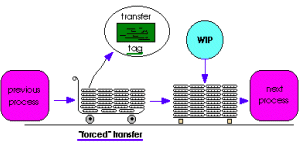 In a push production method, workpieces manufactured by a previous process are transferred ("forced transfer") to the next process irrespective of its readiness to receive and process those workpieces. This normally generates WIP - work in progress. In a push production method, workpieces manufactured by a previous process are transferred ("forced transfer") to the next process irrespective of its readiness to receive and process those workpieces. This normally generates WIP - work in progress.
It is well possible and normal that several batches of workpieces produced by different previous processes "pile-up" and queue before being processed by the downstream process.
Consequently, there is a time gap and an associated "localisation" problem between two consecutive production processes.
Because of this, manufacturing planning becomes very sophisticated and requires specialised tools such as RVP - Required Volume Planning, MRP1 - Materials Requirement Planning, MRP2 - Manufacturing Resources Planning, and the like.
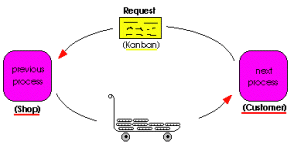 In a pull production method, next process down "pulls" from the previous process just what needed, only when needed, and in the quantity needed. In a pull production method, next process down "pulls" from the previous process just what needed, only when needed, and in the quantity needed.
Nothing happens upstream unless something happens downstream.
The value-chain principle is fully implemented: there is a supplier-client relationship between upstream and downstream processes.
Production planning is simpler, immediate, fit for human beings.
The famous Kanban (more ») is an example (not the leanest) of a pull production method.
THE BATCH/ECONOMIC LOT vs. THE FLOW PROCESSING METHOD
The "mass-production era" of the 50s - 60s - 70s has left a heritage to manufacturers: the batch and economic lot principles, invented to cope with an un-saturated, demanding market and to mitigate the negative impact of long machine/line set-up times.
Then, gradually, clients started their "mutation" and became monsters.....
There are major differences between a batch and a flow style of production.
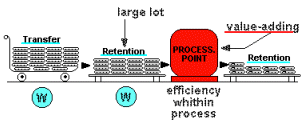 A batch situation is normally characterised by narrow variety of products and "large" lots. Lots must be "conveyed" between processing stations. Lots are normally "retained" before being processed by next processing station - this generates WIP. The focus is on "efficiency within the processing station". The flow of materials is a "hiccup" flow (stop and go). A batch situation is normally characterised by narrow variety of products and "large" lots. Lots must be "conveyed" between processing stations. Lots are normally "retained" before being processed by next processing station - this generates WIP. The focus is on "efficiency within the processing station". The flow of materials is a "hiccup" flow (stop and go).
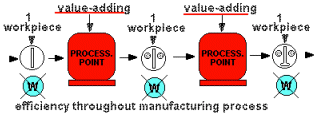 A flow style of production is normally suited to a wide variety of products and small lots situations. A flow style of production is normally suited to a wide variety of products and small lots situations.
In a flow style, value-adding processing stations are close-by and strictly linked the one to the other. Little conveyance between processing points, or none at all, is required. There is no retention: workpieces are immediately transferred to downstream stations (no WIP). The flow - ideally one-piece flow, whenever possible/feasible - is smooth, regular, continuous. The focus is on efficiency throughout the overall manufacturing process.
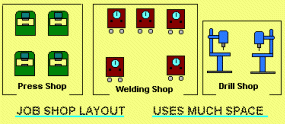 A job-shop type of layout is traditionally allocated to batch operations. A job-shop type of layout is traditionally allocated to batch operations.
This is a "horizontal" layout. Similar machines are grouped in well defined areas, and perform well defined processing operations "in batch". This layout uses considerable floor space, mainly because of the "retention" points necessary to accommodate large lots.
 A flow-shop type of layout is well suited to flow operations. A flow-shop type of layout is well suited to flow operations.
This is a "vertical" layout. Different pieces of equipment are positioned according to processing sequence, catering for a continuous flow of workpieces between them.
The required floor space is minimal, and there is no need to allocate any goods retention point, except at the entrance and the exit of the flow-shop. In the most ideal situation, the flow-shop is the entire factory: raw materials are received at the one end and finished products are despatched at the other end.
 In batch processing, normally performed in a job-shop type of layout, single-skilled and often very specialised workers execute single-operations. In batch processing, normally performed in a job-shop type of layout, single-skilled and often very specialised workers execute single-operations.
This is a direct application of Smith's principle of labour division.
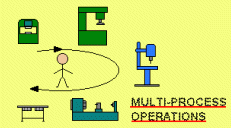 In flow processing, normally performed in a flow-shop type of layout, multi-skilled workers execute a number of different processing operations, handling different machines and tools. In flow processing, normally performed in a flow-shop type of layout, multi-skilled workers execute a number of different processing operations, handling different machines and tools.
This is a direct application of the Process Engineering principle of labour integration.
There are other major differences between the two production styles:
- In-process stock can be very high in a batch situation, whereas it can be reduced drastically in flow situations.
- All lead times are normally high in a batch situation. The throughput time can be minimised (and theoretically reduced to the sum of value-adding times) in a flow situation.
- The batch style is generally quality control based, whereas the flow style always attempts to be in-process quality assurance based, with the necessary controls performed by the same multi-skilled workers producing the product.
- Equipment for batch production is normally: large-capacity, large-size, high-speed, often general-purpose, expensive, difficult to move, long to set-up, requiring specialised and often sophisticated maintenance, operated by a single-skill specialised operator. The focus is on high efficiency (shortest cycle-time).
Equipment for flow production is rather: smaller capacity, compact, adequate in speed, specialised/dedicated, inexpensive, easily movable, easy and fast to set-up, easy and fast to maintain, operated by a multi-skilled operator. The focus is on quality. (more »)
|

